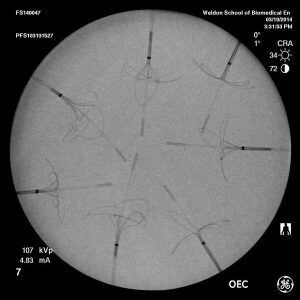Radiopacity Evaluation
Top 3 Challenges for Radiopacity Evaluation
The ability to visualize a minimally invasive medical device or product during use is an important consideration during the development and regulatory review of that medical device. Mitigating risk associated with medical device or product development is an important and necessary activity. There are several standards to guide us to appropriate evaluation activities. ASTM F640 has been around since the 1970s and is an important reference for medical devices and products. There are other standards such as ISO 5361 specific to tracheal tubes, and ISO 4049 for dental implants that need to be considered based on the indication of the device or product.
 We have successfully evaluated numerous medical devices for radiopacity and have supported global regulatory submission with our testing, acceptance criteria development, worst case model creation and validated methods. Our experience includes neonatal devices, picc lines, access devices, implants and accessories or supplies. As with most medical device related risk mitigation activities, it is important to stay current on technology, testing standards, and regulatory expectations. Likewise, consulting companies like MED are able to be more efficient and cost effective by amortizing the cost of expensive testing equipment, the cost of validation of the test method, and on-going expenses to maintain method accreditation across numerous projects over many years.
We have successfully evaluated numerous medical devices for radiopacity and have supported global regulatory submission with our testing, acceptance criteria development, worst case model creation and validated methods. Our experience includes neonatal devices, picc lines, access devices, implants and accessories or supplies. As with most medical device related risk mitigation activities, it is important to stay current on technology, testing standards, and regulatory expectations. Likewise, consulting companies like MED are able to be more efficient and cost effective by amortizing the cost of expensive testing equipment, the cost of validation of the test method, and on-going expenses to maintain method accreditation across numerous projects over many years.
The most common challenges to evaluating radiopacity of a medical implant are:
- Selection and creation of a worst-case phantom, in other words, understanding the attenuation of the human body and how to apply that attenuation consistently with a validated model. We have done this for every part of the human body and enjoy leveraging our experiences with our clients to find the most appropriate model or phantom to use for the client’s given indication;
- Determining if the test should be qualitative or quantitative and what the radiopacity value should be is the second challenge;
- Determining an appropriate sample size adequate for de-risking the device is a common question either if you are submitting a test to a global regulatory body or determining if a new device is equivalent to a predicate during the research and development phase.
To learn more about our services and how we can partner with you, please visit medinstitute.com call us at 855.463.1633 or send us an email askmed@medinstitute.com.
Get email about news, services, and events from MED Institute.
OUR COMMITMENT
We are committed to consistently performing services with high quality, that deliver exceptional results, and add value to the client’s business.
For client surveys sent in 2024, we received ratings of 4.98/5 points (13).

